SOUTHAMPTON
July 2020
Southampton has a rich history dating back to the time of the Roman Empire. There are many beautiful buildings in the city, each with a story to tell. This city is particularly famous for its association with the Spitfire, Hovercraft, Flying Boat, Jane Austen and much more.
Join me on a tour of Southampton and let's explore it fascinating history together.
LYNDHURST
July 2020
Lyndhurst is the unofficial capital of the New Forest. There is something for everyone in this town. St. Michael & All Angels Church at the top of the hill has some beautiful stain-glass windows designed by Edward-Burne Jones, the pre-raphaelite artist, and is home to the grave of Alice Hargreaves aka 'Alice in Wonderland'. The high street is full of interesting shops, cafés and pubs. If you like antiques, then the antique shop at the top of the high street is an Aladdin's cave. At the bottom of the high street is a Ferrari dealership. ? Join me on a tour of the New Forest and discover its treasures.
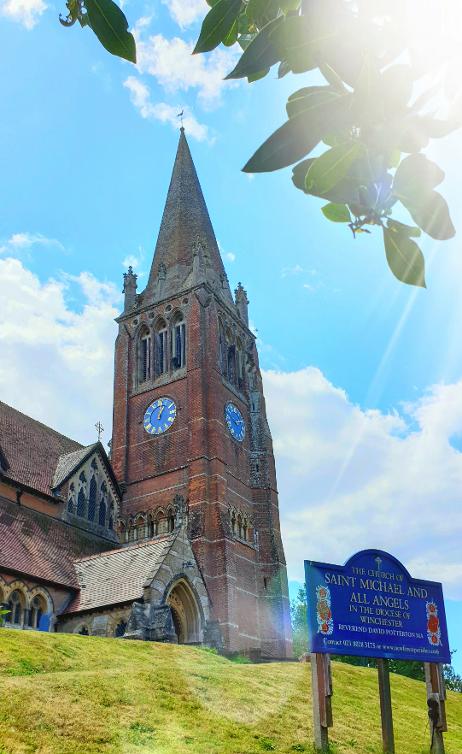
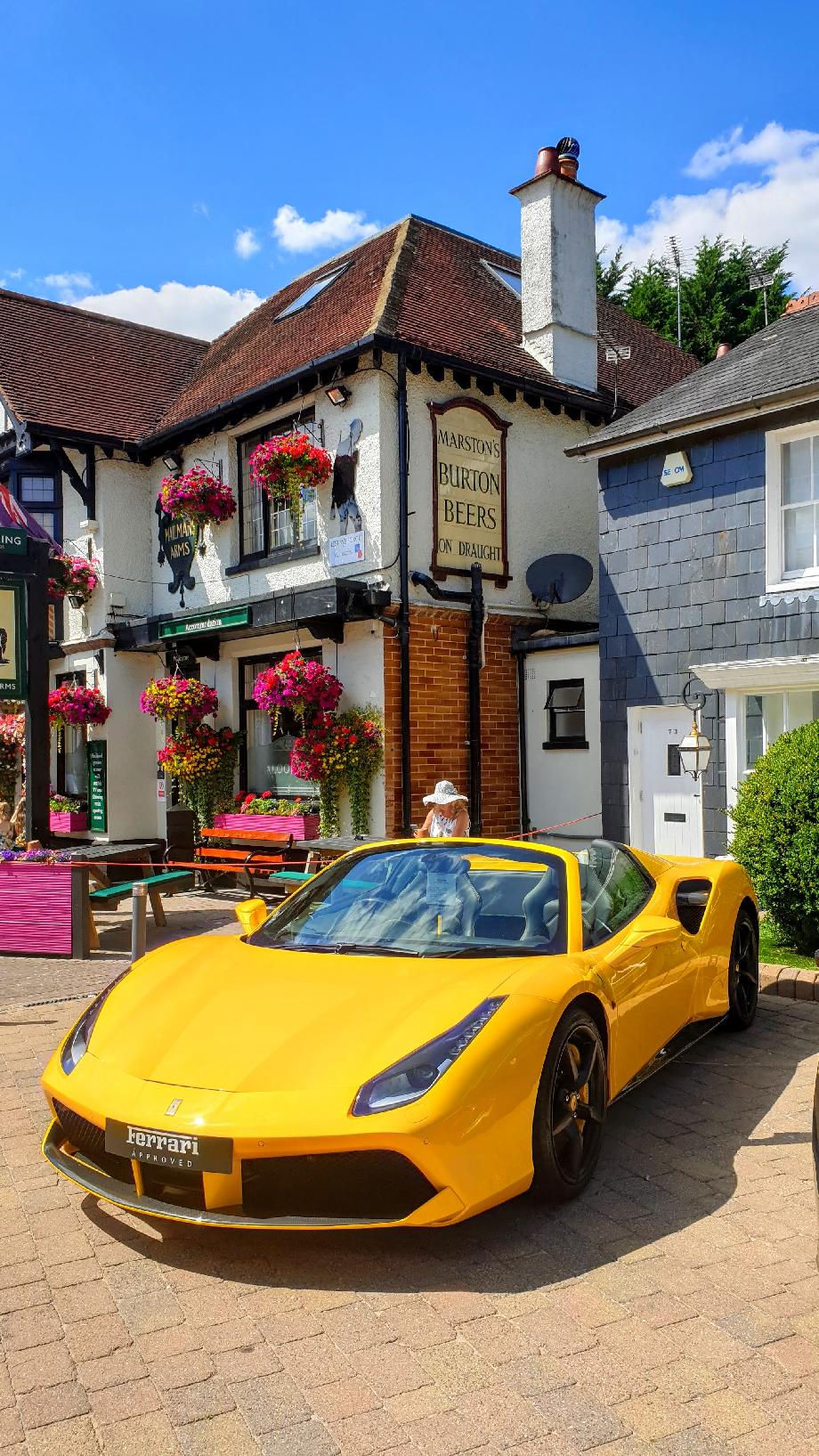
BELFAST
July 2019
Belfast is an amazing city, full of history and beautiful buildings. The Titanic Museum tells the story of shipbuilding in Belfast and in particular, the Titanic. They are proud of their shipbuilding tradition. We say,"but the Titanic sank". They say,"well, she was alright when she left us!" You can also see the political murals, painted on the sides of the houses. They make a very strong statement to the world. Guinness was invented by Arthur Guinness in Ireland. Irish Guinness tastes better than anywhere else in the world, especially washed down with a Bushmills Black Bush Whiskey chaser! ;-)
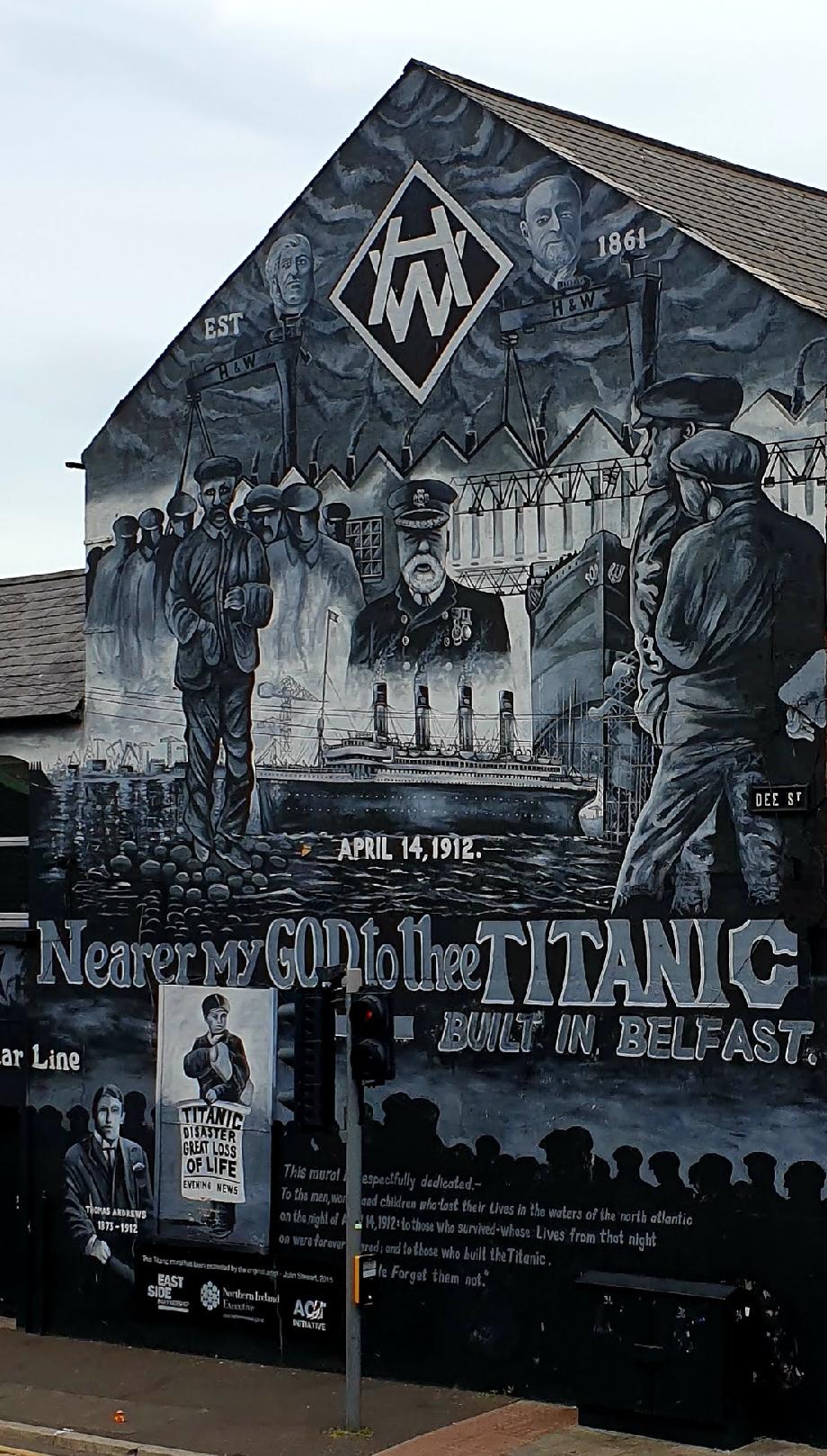
THE NEW FOREST
June 2019
The weather today was perfect for a coach tour. We drove through the New Forest on our way to Salisbury and Stonehenge. The New Forest Ponies have the right of way on the roads. You must slow down and even stop, if the ponies are standing in the road. Unfortunately, ponies do get injured and even die, as traffic and animals do not mix well. Join me on a tour of the New Forest, and learn all about the ponies and other commonable animals.
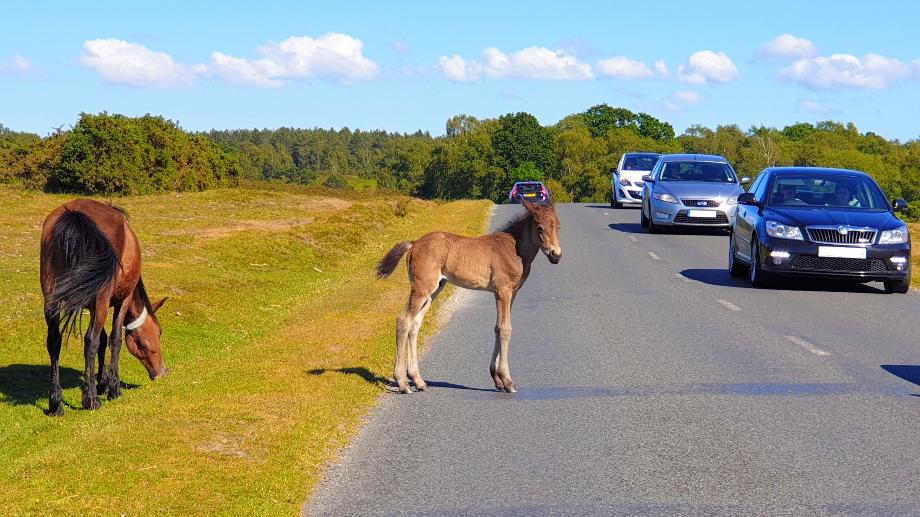
walking tour - isle of wight
May 2019
It was my pleasure to show some German and Swiss tourists from the cruise ship 'Hanseatic Nature' around the Isle of Wight. We walked along the coastal path from Shanklin to Ventnor, visiting Old St. Boniface Church along the way. St. Boniface spread Christianity to Germany during the 8th century, and became the Patron Saint of Germania, and the Apostle of the Germans.
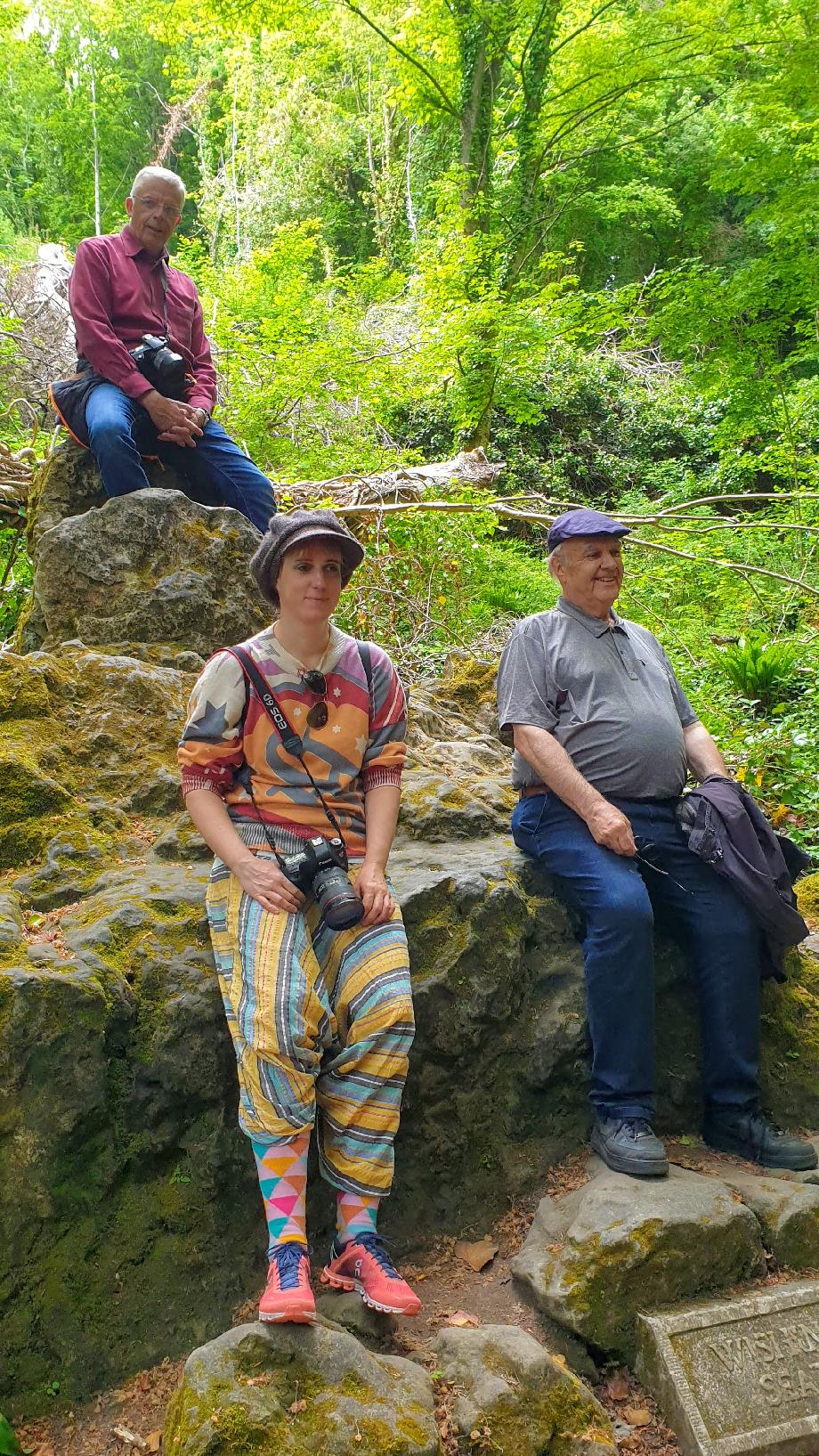
STONEHENGE
May 2019
I had the pleasure of showing members of the gold medal winning Ukrainian Invictus Team around Stonehenge today. All 3 members of the team won gold medals in Archery at the Sydney Games in c.2018.
They are here to support the Halo Trust, which leads the effort to protect lives and restore livelihoods for those affected by conflict. Princess Diana helped to raise awareness by walking through a minefield in Angola in c.1997, as did Prince Harry in c.2013.
There is a sponsored walk on 25th May to raise funds for the charity:
https://www.halotrust.org/support-us/safe-steps/
If you don't fancy a walk, then you can always make a donation to help this essential work to continue.
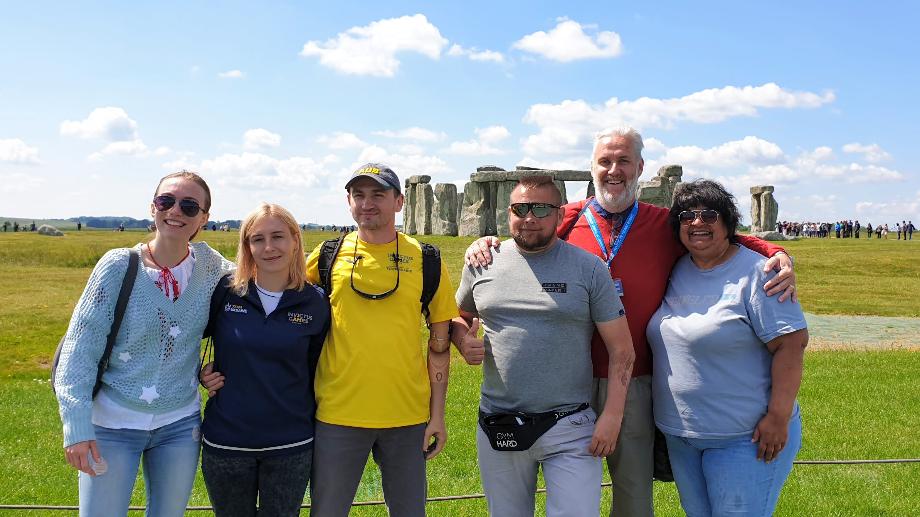
PORTSMOUTH HISTORICAL DOCKYARD
May 2019
I had the pleasure of taking Sandy and Steve from Canada on a tour of Portsmouth.
First, we visited the Historical Dockyard - the Mary Rose (Henry VIII's Tudor warship), and HMS Victory (Admiral Nelson's flagship at the Battle of Trafalgar), then took a mini-cruise around the port, looking at the naval ships. The cruise ship dropped us off at Gunwharf Quays, where we had lunch in a pub. Sandy and Steve got to try some real English Ale (London Pride).
From there, we did a little walking tour of Old Portsmouth, visiting Spice Island and the Garrison Church along the way.
It's incredible who you meet on tour. Steve was involved in the group that dived on the wreck of the Titanic, and worked with James Cameron, the director of 'Titanic' c.1997 that starred Leonardo DiCaprio and Kate Winslet.
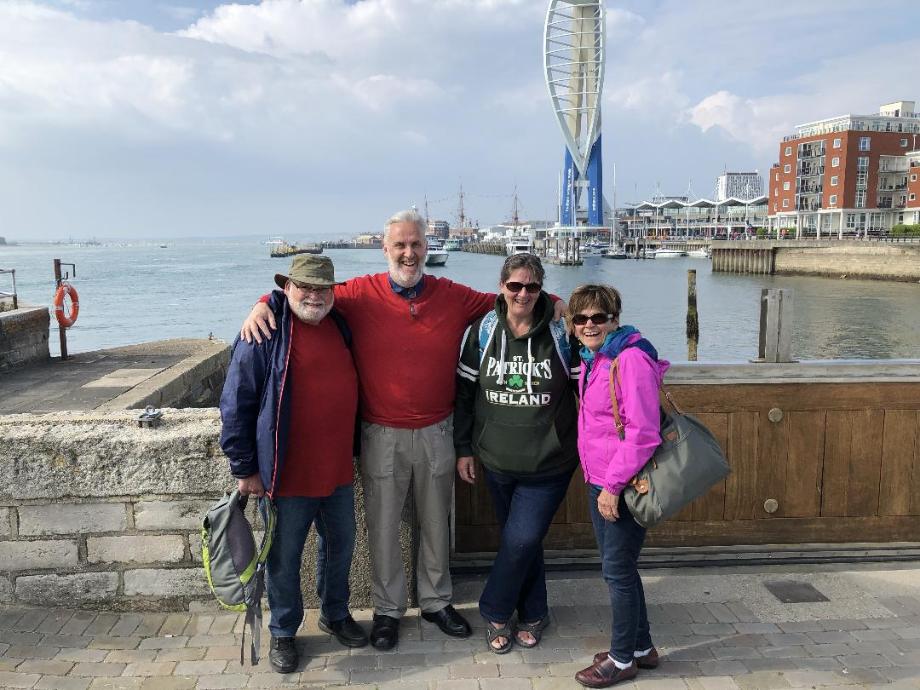
WINCHESTER
May 2019
Winchester is the ancient capital of Wessex, and the home of King Alfred the Great.
Join me on a tour of Winchester to see some amazing things, like a 12th century illuminated bible, King Arthur's Round Table, and maybe even the ghost of Alice Lisle....
ARUNDEL Castle
April 2019
Arundel Castle is one of the most ancient and beautiful castles in England, dating from the reign of William the Conqueror c.11.
Join me on a tour of the castle, learn about the Howard family and the 18th Duke, the hereditary Earl Marshall of the College of Arms, founded in c.1484 by Richard III.
JAMMIN' WITH JAMAICANS !
19th October 2018
Today I had a coach tour to Stonehenge and Salisbury with a group of Jamaican tourists. They were the most fun group of tourists that I have ever worked with. We had a great time, even though there were problems along the way. Right from the start of the day, the coach driver was 30 minutes late. Normally, people would be getting annoyed and showing their displeasure. My group were laughing and joking, as though there was nothing wrong. Later, at Stonehenge, when I went to get the tickets, the driver had left the coach with the tourists locked on-board. I came back to the coach, and had to break them out using the emergency door switch. Even that didn't upset them.
When we arrived in Salisbury, the first stop was the beautiful 13th century cathedral, then we took a short walk to the market square, where the tourists had free time to explore the shops and cafes. There was a band playing (Celebration Samba), and 3 of my guests decided to join in (see photo below). They could not resist the temptation to have some fun.
My group even managed to teach me some Jamaican Creole along the way.
I love my job and when you have a group of tourists that are so engaging and fun, it's the best job in the world.
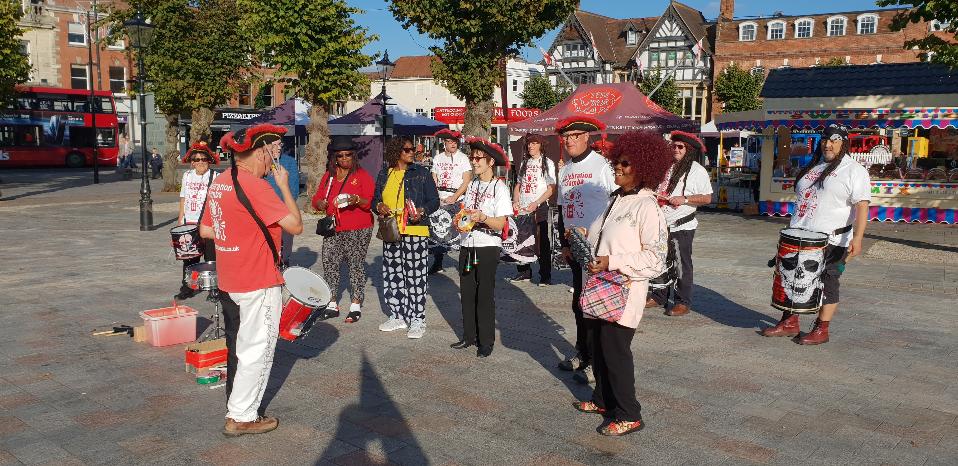
RMS TITANIC
April 2018
Join me on a 'Titanic Trail' walking tour. Visit buildings in Southampton and learn about their connections with the famous ship.
We shall also visit the 'Titanic' exhibition in Seacity Museum, and see genuine artefacts and hear survivors talk about their experiences.
BEAULIEU MOTOR MUSEUM
October 2017
OXFORD
October 2017
d-day centre
September 2017
OSBORNE HOUSE
18.09.2017
st. nicholas church
18.08.2017
CORFE CASTLE
August 2017
THE MID HANTS RAILWAY 'WATERCRESS LINE'
July 2017
The Mid-Hants Railway is a heritage railway that runs for 10 miles from New Alresford to Alton in the county of Hampshire.
The railway line was originally built in 1865 for the local farmers to send their produce up to London. One was the main crops was watercress, hence the nickname 'Watercress Line'. The railway line closed down in 1973.
In 1975 a group of enthusiastic volunteers raised enough money to purchase the railway line from British Rail. They started to renovate the railway and opened the line between New Alresford and Ropley stations on 30 April 1977. Ropley Station is also the location of the workshops where the engines and coaches are restored and repaired. As more funds were raised the group managed to open up the line to Medstead / Fourmarks in 28 May 1983 and finally to Alton in 25 May 1985. Today, the Watercress Line is run by a small group of full time staff and over 400 volunteers.
Medstead and Fourmarks Station is the railway highest station in Hampshire at 194 metres above sea level. Here you can find an exhibition in the waiting room illustrating the history and transformation of the station.
Ropley Station is the engineering centre with workshops. You can also see beautiful flowerbeds and topiary. This station is also famous for it's footbridge. The Kings Cross Footbridge was originally located at Kings Cross Station in London, and was used in the Harry Potter film 'Harry Potter and the Sorcerer's Stone', when Hagrid gave Harry his ticket on the Hogwarts Express.
Alton Station is shared between The Watercress Line and South West Trains. Here you can find the 3 steam cranes used by the railway. The town centre is only a 10 minutes walk away where you can find the Curtis Museum with a large local history collection. Jane Austen's house in Chawton is only a couple of miles from Alton.
New Alresford station is the most southern station located in a beautiful Georgian town, only a 2 minute walk away. This station has the most facilities with a museum, buffet and 2 shops. Most of the carriage stock is stored at this station. There is also a picnic area, which has been known to be used on occasion. ;-)
GOODWOOD ESTATE
March 2017
The Goodwood Estate covers 12,000 acres of land in West Sussex, just a few miles from Chichester. Goodwood House dates from c.1600 and came into the family of the 1st Duke of Richmond in 1697 (the illegitimate son of Charles II). The Dukes of Richmond have owned the Goodwood Estate ever since.
Lord March, heir-apparent to the 10th Duke of Richmond, is the owner of the estate, which has diverse business interests including, a 90 bed hotel, a horse racing track, a motor circuit, an airfield, 4,000 acre organic farm, and two 18 hole golf courses. Lord March brought motor racing back to the estate with the 'Festival of Speed' in 1993 and 'Goodwood Revival' in 1998.
The airfield was originally known as RAF Westhampnett, and was built as a relief airfield to RAF Tangmere. 145 & 602 RAF Fighter Squadrons and 308 & 309 USAF Fighter Squadrons flew Supermarine Spitfires from here. There is a bronze statue of Douglas Bader at the airfield. He was an Ace Fighter Pilot, shooting down 22 enemy planes during the Battle of Britain (1940), and was famous for flying planes with tin legs. He lost his legs in an accident whilst performing an aerobatic manoeuvre. In 1941 he was shot down over enemy territory and sent to Colditz. He kept trying to escape, so the German soldiers confiscated his tin legs during the night. You can actually fly as a passenger in a Spitfire at Goodwood today if you have £3,000 to spare....!
After the 2nd world war the perimeter road of the airfield was converted to a motor racing circuit. From 1948 to 1966 cars and motorcycles raced at Goodwood. Many famous F1 World Champions raced there including Mike Hawthorn, Graham Hill, Jim Clarke, and Jackie Stewart. Roger Penske, an American NASCAR driver and later team owner, also raced at Goodwood. Racing stopped when the powers that be wanted to add chicanes to the track and the owner point blank refused. A chicane is an 'S' bend, designed to slow down racing cars safely.
Lord March wanted to re-introduce motor racing back to Goodwood, but he didn't have the necessary permit, so held the races in the grounds of Goodwood House. The 'Festival of Speed' is held at a hill-climb in the grounds of the house during June and July, depending on the dates of the F1 and 24H Le Mans races (Lord March never lets the Festival of Speed dates clash with other racing events). Goodwood Revival is an event held every year for 3 days in September, where period cars and motorcycles (from the 40s to 60s) participate in a series of races at the motor circuit. Famous championship winning drivers like Jackie Stewart and Stirling Moss still race at the Revival.
There is horse racing at Goodwood from May to September, with the highlight of the year being 'Glorious Goodwood', held this year from the 1st - 5th August. Notable races include the Steward's Cup, Nassau Stakes, Sussex Stakes and the Goodwood Cup. Horse racing has been held here since the 18th century. This year the racing season will be televised on ITV (the 3rd channel on British television).
The Rolls Royce factory is based on the Goodwood Estate. In 1998 BMW bought Rolls Royce and built this factory in 2003. Rolls Royce currently build 5 models including the Phantom, Phantom Coupe, Wraith, Dawn, Ghost and from this year will produce and SUV.
Rolls Royce was founded by Charles Rolls and Henry Royce in 1904 and they were based in Manchester. They produced 4 models from a 2 cylinder 10HP model to a 6 cylinder 30HP model, ranging in price from £40,000 to £90,000 in today's money. The first production of cars were built without the iconic radiator badge known as the 'Spirit of Ecstasy', which adorned cars from 1911. The Spirit of Ecstasy was modelled on Eleanor Thornton, the Secretary and Mistress of the 2nd Lord Montagu, and designed by Charles Sykes. Charles created a design prior to the Spirit of Ecstasy, which was called the 'The Whisper' because Eleanor had her forefinger against her lips. Only 4 copies of the Whisper were made, and you can see them at the Beaulieu Motor Museum in Hampshire.
a walk through 8OO years of SALISBURY
25th September
The weather was perfect today; sunny with a light breeze.
We started our walk from the Tourist Information Centre in Fish Row, passing by the market place and St. Thomas's Church, and ending up at the west front of the Cathedral.
The city of Salisbury was developed with the construction of the cathedral. Salisbury was originally located at Old Sarum; an Iron Age Hillfort, approximately 2 miles north of its present location. Roads were built from north to south and intersected by roads running from east to west, forming the shape of a chequer board. Each square was a chequer and was named after an important person or pub. The chequer would have buildings built in a square shape with a central area, which would have either been an open courtyard or garden. The layout of the medieval part of Salisbury remains the same today.
There are 2 markets in Salisbury. The first market was started in 1227 on a Tuesday, when Salisbury received a charter from Henry III. The next charter from Edward II came in 1315 to have a market on Saturday. These markets still operate today. There are street names which are named after the product that they sold. Ox Row which runs along the side of the market place is now a row of old buildings. These were once market stalls.
There is a statue of Henry Fawcett in the market place. Henry was born in Salisbury and grew up to achieve many great things. He was an Economist, an MP for Brighton, and Postmaster General of the Post Office, inventing the postal order and parcel post. He was blinded from a hunting accident at the age of 25, so life wasn't easy. He died in 1884 at the young age of 51 from pleurisy. His wife was Millicent Garrett, a non-militant Suffragette (unlike Emily Pankhurst who was very militant). She campaigned for women's rights, and played an integral part in the repeal of the Contagious Diseases Act, which protected prostitutes from prosecution from men who had contracted some disease. She argued that there should be a reciprocal law so that the girls could prosecute the clients who had infected them.
St. Thomas's Church was originally built for the stone masons who built the new cathedral. The church was later rebuilt from stone. The bell tower was built from 1400 and has a clock with quarter-jacks. The Doom Painting inside the church is magnificent. Doom is an Anglo Saxon word that means 'Judgement', and the painting is of judgement day, when you either go to heaven or hell. Jesus is sitting on a rainbow at the top with his 12 Apostles below. Either side is the Virgin Mary and John the Baptist. Below that are people rising from their graves, either being helped by Angels to rise up to heaven, or by devils to be dragged down to hell via a monster's mouth.
The painting was made in 1470. At that time many people couldn't read, but they could understand stories in the form of pictures. During the dissolution of the monasteries during the reign of Henry VIII the painting was white-washed over. It was re-found in the early 19th century, then covered over again..?! At the end of the 19th century the painting was uncovered again and restored. Today is it covered in a layer of silicone to protect it.
Walking along New Canal Road we spoke about the watercourses that ran through the streets of medieval Salisbury. The city was known as the Venice of England. These watercourses were the cause of cholera and as a consequence were filled in, and a proper sewage system was built underground.
Travelling further along the High Street towards the cathedral, we stopped at the Mitre House, which is where Bishop Poore lived while the cathedral was being built and where new Bishops are enrobed before entering the cathedral.
Passing the fudge shop with a display of 'Fudgehenge' in the window, we pass through the gateway and in to the cathedral close, passing Bishop Seth Ward's almshouses (1682) where you can see a lion with human teeth, and a fire insurance wall plaque from the Sun Fire Office (1710).
The Cathedral Close was built at the same time as the cathedral to house the clergy. Bishop Poore gave each person a plot of land, and they had to build a house. Today, there are many interesting buildings, dating mostly from the 1700s, that include schools and museums. 'Arundells' was the residence of Edward Heath, who was the Prime Minister of Great Britain from 1970-74. He brought the UK into the European Economic Community in 1973.
We finish our walk outside the west front of the cathedral. Here you can admire the beautiful statues that date from the 14th century. The statues are situated on different levels, with Jesus in Majesty at the top, then we have the Archangels and Angels, then the Prophets, then the Apostles, then the Saints, and last but not least, the Worthies. One of the newest sculptures is of Canon Ezra. He was killed in cross-fire during the Sudanese civil war in 1991. The sculpture was made by Jason Battle and installed in 2008 as part of the 750th anniversary of the consecration of the cathedral and 30th of the Sudan - Cathedral relations.
the titanic WALK OF SOUTHAMPTON
19th September 2016
We start the walk with a visit to SeaCity Museum, where we explore the Titanic Exhibition.
The 'Titanic' story from the Sotonian perspective is one of loss and sadness. 550 people from Southampton, who served as crew on the Titanic, lost their lives. There was no Social Security in those days. If you didn't work, then you went hungry. Men would stand outside the dock gates every morning, hoping to get chosen to do a day's work. The moment that Titanic sunk, White Star Line stopped paying the crew's salaries. They were discharged at sea. Crew on the Titanic had to pay for their own uniforms, and usually did so by paying in installments. Families of the dead crew received the uniform bills for their deceased. Relief funds were set up to help these families make ends meet. A total of £40 million in today's money was raised and the last relief fund paid until the 1960s.
From the museum we make our way towards the eastern docks. The majority of the crew lived close to the docks. There is a map on the floor of one of the exhibition rooms in the Titanic Exhibition with red spots. Each red spot represents a household where at least one member of the crew lived. By far the majority of red spots are in the dock area. The highest spot north of the docks is the household of Captain Smith, who lived in Winn Road.
Milvina Dean was the last living survivor of the Titanic. She spent the latter years of her life living in Ashurst in the New Forest. She was a local celebrity and passed away in 2009 at the grand old age of 97. Milvina was a 9 week old baby on the Titanic and a mail sack was used to lower her in to the lifeboat.
Places of interest include Briton Street where Jack Dawson lived, Oxford Street where many crew lived in the Sailor's Home, and pubs like the Grapes where the Slade brothers were drinking before running to the ship and missing the voyage due to a passing train. Also, there is the Terminus Terrace Railway Station where the 1st class passengers arrived from London, Waterloo. They stayed at the South Western Hotel next door, before boarding the Titanic. The famous Grand Staircase on the Titanic was copied from a staircase in the South Western Hotel.
From the Hotel, we make our way back to the Cruise Ship at berth 38/39, passing Berth 44 where Titanic was berthed, and talking a little about port operations along the way.
the city of chichester
9th September 2016
Today, I met some German tourists at the Portsmouth International Port, and we went to visit the city of Chichester and the cathedral.
Chichester is a beautiful bijoux city in West Sussex. The city has a rich history from the time of the Romans, and boasts a beautiful cathedral, The Novium Museum, The Pallant House Art Gallery, and nearby, the Fishbourne Roman Palace.
Chichester was inhabited by the Regni tribe when the Romans came to Britain in 43 AD. The Romans fortified the city and called it 'Noviomagus Reginorum'. The wall was 2 metres thick with a steep ditch. The main Roman roads ran from Chichester to London and Silchester (Calleva Atrebatum).
When the Romans left Britain the Anglo Saxons took control of the city, and according the the 'Anglo Saxon Chronicles', the city was re-named 'Cissa's Ceastor', after the son of Aelle, giving Chichester it's name today.
During the reign of the Normans, the Domesday book listed Chichester as having 1500 residents and 300 dwellings. After the victory at the Battle of Hastings in 1066, William the Conqueror gave Chichester to Roger de Mongomerie, the 1st Earl of Shrewsbury as a reward for his bravery in battle.
Chichester is also famous for being the place where the Hawkhurst Gang were tried and executed. They were a notorious gang of Smugglers in the 18th century who were known for their brutality. They operated from Dorset to Kent.
Just a few miles down the road is the Goodwood Racing Circuit and today is the first day of a 3 day festival called 'Goodwood Revival' where racing cars from the 1940s to 1960s are raced around the track. Many famous racing drivers have participated in the Revival, including Sir Sterling Moss, John Surtees, Derek Bell, Damon Hill, David Coulthard and Martin Brundle.
The Rolls Royce factory is also close the Chichester. Rolls Royce produce prestigious luxury cars that are favoured by Royalty and successful businessmen. The company was founded by Charles Rolls and Henry Royce in 1906 and the cars have a starting price of £235,000. The bonnet decoration is called the Spirit of Ecstasy (a winged woman) and was modelled on Eleanor Thornton, who was the Secretary of Lord Montagu, the owner of the Beaulieu Estate in Hampshire.
On the return journey to Portsmouth, we enjoyed wonderful views of the coastline that stretch from Chichester Harbour to Hayling Island and Farlington Marshes. Hayling Island is an ANOB (area of outstanding natural beauty) and and SSSI (site of special scientific interest) and is home to more than 50,000 birds throughout the year. It is also very popular among the sailing fraternity with 14 sailing clubs.
On arrival back in Portsmouth the Spinnaker Tower is a welcome site . The Tower is 170 metres high and you can go up to the viewing platform to enjoy panoramic views of Portsmouth harbour. There is also a glass floor to walk across and test your nerve....
WALKING TOUR OF DURDLE DOOR AND LULWORTH COVE
6th September 2016
Durdle Door and Lulworth Cove are part of the Jurassic Coast, which is a World Heritage Site. The coastline stretches 95 miles from Exmouth in East Devon to Studland Bay in Dorset and covers 185 million years of geological history.
Tourists arrived in Portland on the cruise ship 'Costa Neoromantica' and we travelled by coach through Weymouth and the beautiful Dorset countryside to Durdle Door. 50% of Dorset is an area of outstanding natural beauty (AONB).
On arrival at Durdle Door, we walked through a wooded area to the coastline and enjoyed the incredible vistas. 'Durdle' is an Old English word that means 'drill or bore'. The beautiful limestone arch is a result of erosion from the sea.
From Durdle Door, we made our way east, across the hill overlooking the coastline to Lulworth Cove. The cove is also a result of sea erosion, which has created a natural harbour.
The Jurassic coast has always been a haven for Smugglers. Charles Weeks was an infamous smuggler in the 1700s who lived in the nearby village of Winfrith and would hide contraband in the village, before sending on to be sold in London.
After visiting the cove, we made our way to the Visitor's centre to learn more about the history of the area, and grab a cup of tea (and slice of cake :-).
On the journey back to the ship, we passed Lulworth Castle, the former family home of the Weld family who own 12,000 acres of Dorset including Lulworth Cove. We also passed George III on horseback, carved in to the hillside.
Walking tour of the New Forest
30th July 2016
Today, I took some visitors on a guided walking tour of the New Forest. It was part of the 80th anniversary of the Campaign for National Parks, and organised by Produce UK and 38 Degrees.
We started off at the Visitor's Centre in Lyndhurst and made our way to Bolton's Bench and the War Memorial, where Ponies and Donkeys congregate to meet the visitors.
The route then took us along the ridge of White Moor, taking in the wonderful views across the heathland and passing a nesting site where you can find Stonechats, Dartford Warblers, Skylarks et al. If you're really lucky, then you might get to see some Deer in the distance.
We crossed the main road and entered Little Holmhill Inclosure, which has a combination of ancient woodland and fir tree plantation. There is a wonderful bog with Sundew plants waiting for their next meaty feast of unsuspecting insects.
Following the pathway down Beechen Lane and on to Pondhead Inclosure, there are wonderful examples of bracket fungi. The Birch Polypore was traditionally used to sharpen cut-throat razors, hence it's other name 'razorstrop'.
In the Pondhead Inclosure there is an area of coppiced woodland, and you can see William's Copse where 900 Sessile Oak Trees were planted to commemorate the 900th anniversary of the formation of the New Forest as a hunting ground by William I (the conqueror).
We walked back towards Lyndhurst, crossing the road and up towards the ridge. From the ridge you get a fantastic view of the spire of St. Michael's Church spire and Notherwood House.
St. Michael's Church is famous as the burial place of Alice Hargreaves nee Liddell, who was the inspiration for Lewis Carol's 'Alice in Wonderland' and 'Alice Through the Looking Glass'. There are stained glass windows designed by Edward Burne-Jones and a Fresco of the 'Wise and Foolish Virgins' by Lord Frederick Leighton.
Northerwood House was built in 1790 by John Nash, who was responsible for much of the layout of Regency London and was a pioneer of 'Picturesque' in architecture. Today, the house is made up of private flats.
On returning back to the Visitor's Centre the guests were free to enjoy the museum (free entry) telling the history of the New Forest from Roman times.
Translate This Page